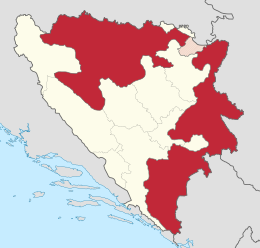More languages
More actions
"Republika Srpska" redirects here. For the Yugoslav Wars entity, see Republika Srpska (1992-1995).
| Republic of Srpska Република Српска | |
|---|---|
 Republika Srpska (red) in Bosnia and Herzegovina | |
| Capital and largest city | Banja Luka |
| Official languages | Serbo-Croatian |
| Dominant mode of production | Capitalism |
| Area | |
• Total | 25,053 km² |
| Population | |
• 2020 estimate | 1,136,274 |
The Republic of Srpska, also known as Republika Srpska, is one of two regions of Bosnia and Herzegovina along with the Muslim-Croat Federation of Bosnia. It was established in 1992 primarly for the safeguarding of Serbians living in Bosnia. This resulted in the displacement of Bosnians and Croats living in the areas of RS while Serbians were displaced from the federation into RS. The Dayton Agreement solidified this separatist entity as its "administrative entity". It is a notable example of divide and conquer based on ethnic grounds by the Western imperialism.[1]
History[edit | edit source]
On January 9th, 1992, the Serb Republic of Bosnia was established as a separatist entity safeguarding Serbian nationalism. Radovan Karadžić was the first president of RS from 1992 to 1996.
Radovan Karadžić was replaced with the monarchist Biljana Plavšić in 1996 since the Dayton Agreement banned him from being in office. Carlos Westendorp, NATO's colonial representative in Bosnia, approved Plavšić's nomination of Milorad Dodik as premier and deployed troops around the Interior Ministry to intimidate the government.
In 1997, Plavšić founded the Serb National Alliance (SNS RS).[2] In August of that year, NATO began seizing police stations and installing new police officers trained by the West. At the same time, NATO troops took over radio and TV stations and teargassed protestors.
In September 1998, despite NATO interference, Nikola Poplašen (awarded as Chetnik Vojvoda by Vojislav Šešelj) won the presidential election.[3][4] NATO tried to make him appoint Dodik as prime minister, and Westendorp removed him when he refused. On the same day, NATO gave the city of Brčko, which connected the two halves of Republika Srpska, to the Federation of Bosnia, preventing Serb troops from moving between the two halves of Srpska without NATO permission.[5]
References[edit | edit source]
- ↑ “Consider, instead, one contemporary parallel, Bosnia: the degree to which the international community via the Owen-Vance plan, or even the later Dayton accord, actively promoted or endorsed the destruction of a multi-ethnic society; the degree to which it helped to facilitate the creation of a greater Serbia or an enlarged Croatia; the degree to which it was, at the very least, an accessory after the fact to both 'ethnic cleansing' and sub-genocide.”
Mark Levene (2000). Patterns of Prejudice, vol. 34: 'The Limits of Tolerance: Nation–State Building and What It Means for Minority Groups'. doi: 10.1080/00313220008559138 [HUB] - ↑ "Biografija Biljane Plavšić" (2009-09-15). Press.
- ↑ Senad Pećanin (1998-09-28). "Intervju Dana: NIKOLA POPLAŠEN" BH Dani.
- ↑ “The election of Nikola Poplasen, a so-called 'Chetnik Duke', to the board of the Agency for Development of Higher Education of Bosnia and Herzegovina, has caused widespread shock.”
Rodolfo Toè (2015-11-13). "Serb Extremist’s Promotion Causes Anger in Bosnia" Balkan Transitional Justice. - ↑ Michael Parenti (2000). To Kill a Nation: 'Republika Srpska: Democracy, NATO Style' (pp. 58–66). [PDF] Verso.


